Front Brake Caliper Overhaul JL9
Tools Required
| • | J 8092 Universal Driver |
| • | J 45507 Caliper Boot Seal Installer |
Caution: Refer to Brake Fluid Irritant Caution in the Preface section.
Notice: Refer to Brake Fluid Effects on Paint and Electrical Components Notice in the Preface section.
Disassembly Procedure
Caution: Do not place your fingers in front of the piston in order to catch or protect the piston while applying compressed air. This could result in serious injury.
Important:
• Replace all the components included in the repair kits used to service this brake caliper. • Lubricate the rubber parts with new Delco Supreme 11®, GM P/N 12377967 (Canadian P/N 992667) or equivalent DOT-3 brake fluid to make assembly easier. • If any hydraulic component is removed or disconnected, it may be necessary to bleed all or part of the brake system. • The torque values specified are for dry, non-lubricated fasteners. • Perform the service operations on a clean bench, free from all mineral oil materials.
- Remove the brake caliper from the vehicle. Refer to Front Brake Caliper Replacement .
- Drain the brake fluid from the brake caliper.
- Place a 25 mm (1 in) block of wood between the caliper and the piston.
- Install a large C-clamp over the body of the brake caliper with the C-clamp ends against the rear of the caliper body and against the block of wood.
- Carefully remove the brake caliper piston by directing low pressure compressed air into the brake caliper inlet hole.
- Remove the C-clamp form the caliper.
- Remove the block of wood from the caliper.
- Install clean cloths to pad the interior of the caliper housing between the remaining caliper piston and the caliper body.
- To cover the open caliper bore place a 25 mm (1 in) block of wood between the caliper body and the brake caliper dust boot seal.
- Install a large C-clamp over the body of the brake caliper with the C-clamp ends against the rear of the caliper body and against the block of wood.
- Carefully remove the brake caliper piston by directing low pressure compressed air into the brake caliper inlet hole.
- Remove the C-clamp form the caliper.
- Remove the block of wood from the caliper.
- Using a small wooden or plastic tool, remove the piston dust boot seal (2) from the seal counter-bore in the brake caliper and discard the boot seal.
- Using a small wooden or plastic tool, remove the piston seal (1) from the brake caliper bore and discard the piston seal.
- Remove the brake caliper bleeder valve cap.
- Remove the brake caliper bleeder valve (1).
- Inspect the brake caliper mounting bracket guide surfaces for corrosion and wear. Remove and replace the brake caliper mounting bracket if damaged or worn .
- Clean the brake caliper piston bores and seal counter-bores with denatured alcohol, or equivalent.
- Clean the brake caliper pistons with denatured alcohol, or equivalent.
- Dry the caliper piston bores and counter-bores with non-lubricated, filtered air.
- Dry the brake caliper pistons with non-lubricated, filtered air.
- Inspect the caliper bores for cracks, scoring, pitting, excessive corrosion.
- If light corrosion is present in the caliper bores, attempt to remove the imperfection with a fine emery paper. If the imperfection cannot be removed, replace the caliper assembly.
- If cracks, scoring, pitting, and excessive corrosion are present in the caliper bores, replace the caliper assembly.
- Inspect the caliper pistons for cracks, scoring, and/or damage. Replace the caliper pistons if any of these conditions exist.
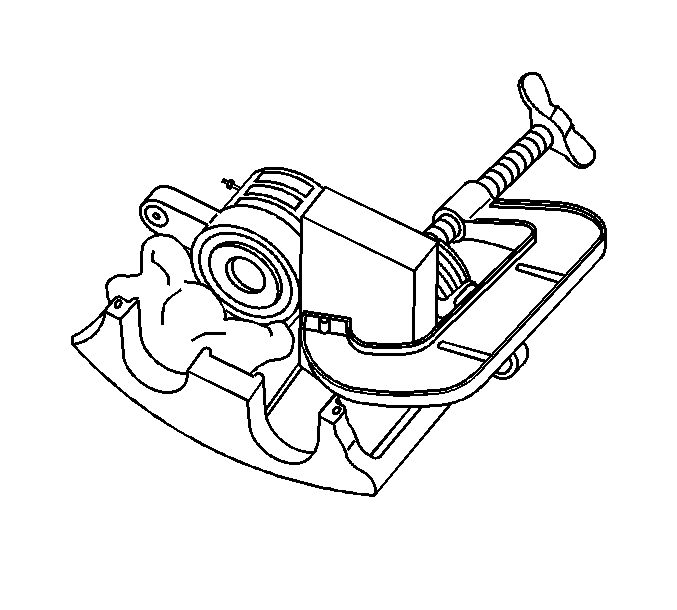
Notice: Use clean cloths to pad interior of caliper housing during piston removal. Use just enough air to ease the pistons out of the bores. If the pistons are blown out, even with the padding provided, it may be damaged.
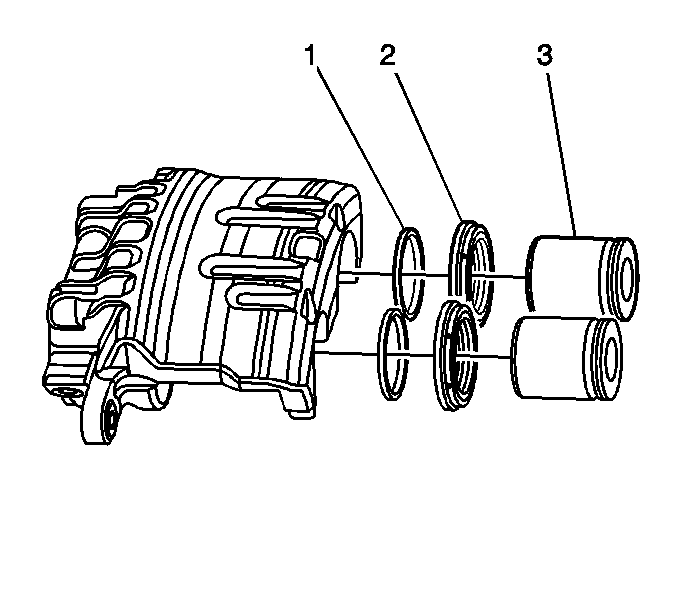
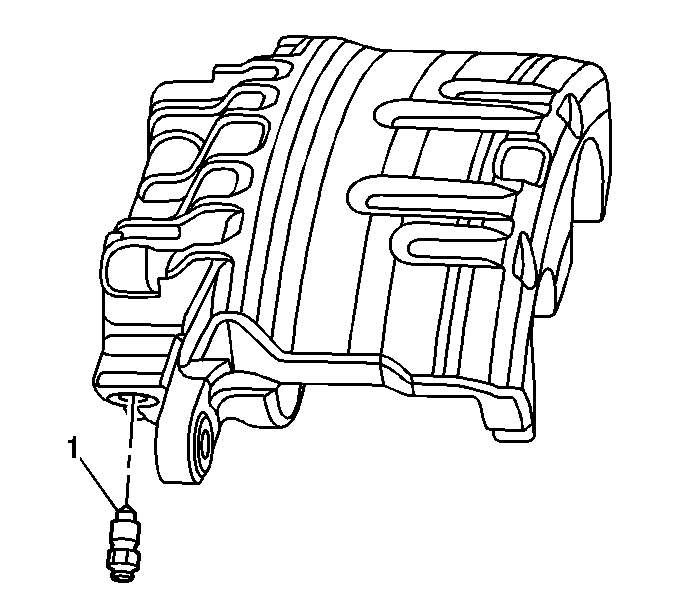
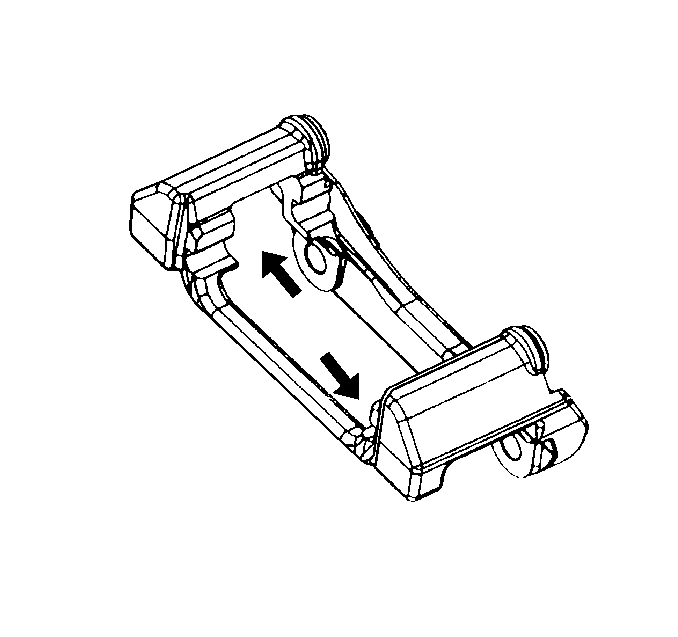
Important: Do not use abrasives to clean the brake caliper piston.
Assembly Procedure
- Install the brake caliper bleeder valve (1).
- Install the brake caliper bleeder valve cap.
- Lubricate the new piston seals (1) with Delco Supreme 11®, GM P/N 12377967 (Canadian P/N 992667) or equivalent DOT-3 brake fluid from a clean, sealed brake fluid container.
- Install lubricated piston seals (1) into the brake caliper bore seal grooves.
- Make sure the seals are not twisted.
- Lubricate the brake caliper bores and the pistons (3) with brake fluid.
- Install the caliper pistons (3) into the caliper bores.
- Install the new piston dust boot seals (2) over the pistons.
- Assemble the J 8092 and the J 45507 .
- Complete the following for both caliper piston dust boot seals (2).
- Install the caliper to the vehicle. Refer to Front Brake Caliper Replacement .
Notice: Refer to Fastener Notice in the Preface section.

Tighten
Tighten the brake caliper bleeder valve to 14 N·m (124 lb in).

| 10.2. | Make sure the caliper piston dust boot is properly seated into the groove in the brake caliper bore. |
Front Brake Caliper Overhaul J56
Caution: Refer to Brake Fluid Irritant Caution in the Preface section.
Notice: Refer to Brake Fluid Effects on Paint and Electrical Components Notice in the Preface section.
Notice: This brake caliper is coated with a specialized paint. Use care when handling and servicing to ensure the paint does not get chipped or scratched. Clean any brake fluid from painted surfaces with denatured alcohol, or equivalent, as soon as possible.
Notice: Do not remove the caliper external crossover tube or separate the 2 caliper halves. If the crossover tube and/or the caliper halves are separated, corrosion and damage to the caliper may result.
Important:
• Replace all the components included in the repair kits used to service this brake caliper. • Lubricate the rubber parts with new Delco Supreme 11®, GM P/N 12377967 (Canadian P/N 992667) or equivalent DOT-3 brake fluid to make assembly easier. • If any hydraulic component is removed or disconnected, it may be necessary to bleed all or part of the brake system. • The torque values specified are for dry, non-lubricated fasteners. • Perform the service operations on a clean bench, free from all mineral oil materials.
Disassembly Procedure
Caution: Do not place your fingers in front of the piston in order to catch or protect the piston while applying compressed air. This could result in serious injury.
Notice: Use clean cloths to pad interior of caliper housing during piston removal. Use just enough air to ease the pistons out of the bores. If the pistons are blown out, even with the padding provided, it may be damaged.
Important: It will be necessary to fabricate one or more blocks of wood to the following dimensions to be used during this procedure:
• Must fabricate 1 block: 19 mm (¾ in) X 51 mm (2 in) X 51 mm (2 in) • Optional to fabricate 1 block, rather than using an old brake pad: 19 mm (¾ in) X 51 mm (2 in) X 127 mm (5 in) • Optional to fabricate 1 block to cushion piston removal: 19 mm (¾ in) X 51 mm (2 in) X 127 mm (5 in)
- Remove the brake caliper from the vehicle. Refer to Front Brake Caliper Replacement .
- Drain the brake fluid from the brake caliper.
- Place the caliper in a vise using plastic vise caps or suitable material to protect the caliper mounting bosses from the vise jaws.
- Place an old brake pad or the fabricated 127 mm (5 in) long block of wood over 2 adjoining piston bores and secure in place with a non-marring C-clamp.
- Place the fabricated 51 mm (2 in) long block of wood over one of the opposing piston bores and secure it in place with a non-marring C-clamp.
- Use clean cloths or the other fabricated 127 mm (5 in) long block of wood to pad the interior of caliper housing during removal of the piston.
- Carefully remove the brake caliper piston by directing low pressure compressed air into the brake caliper inlet hole. If the dust boot seal slides out with the piston, remove the dust boot seal from piston and reinstall the seal into the caliper.
- Move the fabricated 51 mm (2 in) long block of wood over the emptied piston bore and secure it in place with a non-marring C-clamp.
- Move the clean cloths or the other fabricated 127 mm (5 in) long block of wood to pad the interior of caliper housing during the removal of the piston.
- Carefully remove the brake caliper piston by directing low pressure compressed air into the brake caliper inlet hole. If the dust boot seal slides out with the piston, remove the dust boot seal from piston and reinstall the seal into the caliper.
- Repeat steps 4 through 10 for the opposite side of the caliper.
- Using care to not scratch or mar the painted surfaces or piston bore, remove all the dust boot seals using a flat-bladed tool. Discard the dust boot seals.
- Using wooden or plastic tool, remove the piston seals (5) from the piston bores. Discard the piston seals.
- Remove both brake caliper bleeder caps and valves (1, 2).
- Remove the caliper from the vise and clean the entire caliper with denatured alcohol, or equivalent.
- Dry the caliper piston bores with non-lubricated filtered air. Make sure the external crossover pipe and the internal fluid ports are clean and free of obstructions.
- Inspect the caliper cylinder bores and piston seal counter-bores for scratches, cracks, pitting, and/or corrosion.
- If the caliper piston bores are scratched, cracked, or pitted, or if corrosion cannot be cleaned with denatured alcohol, replace the caliper assembly.
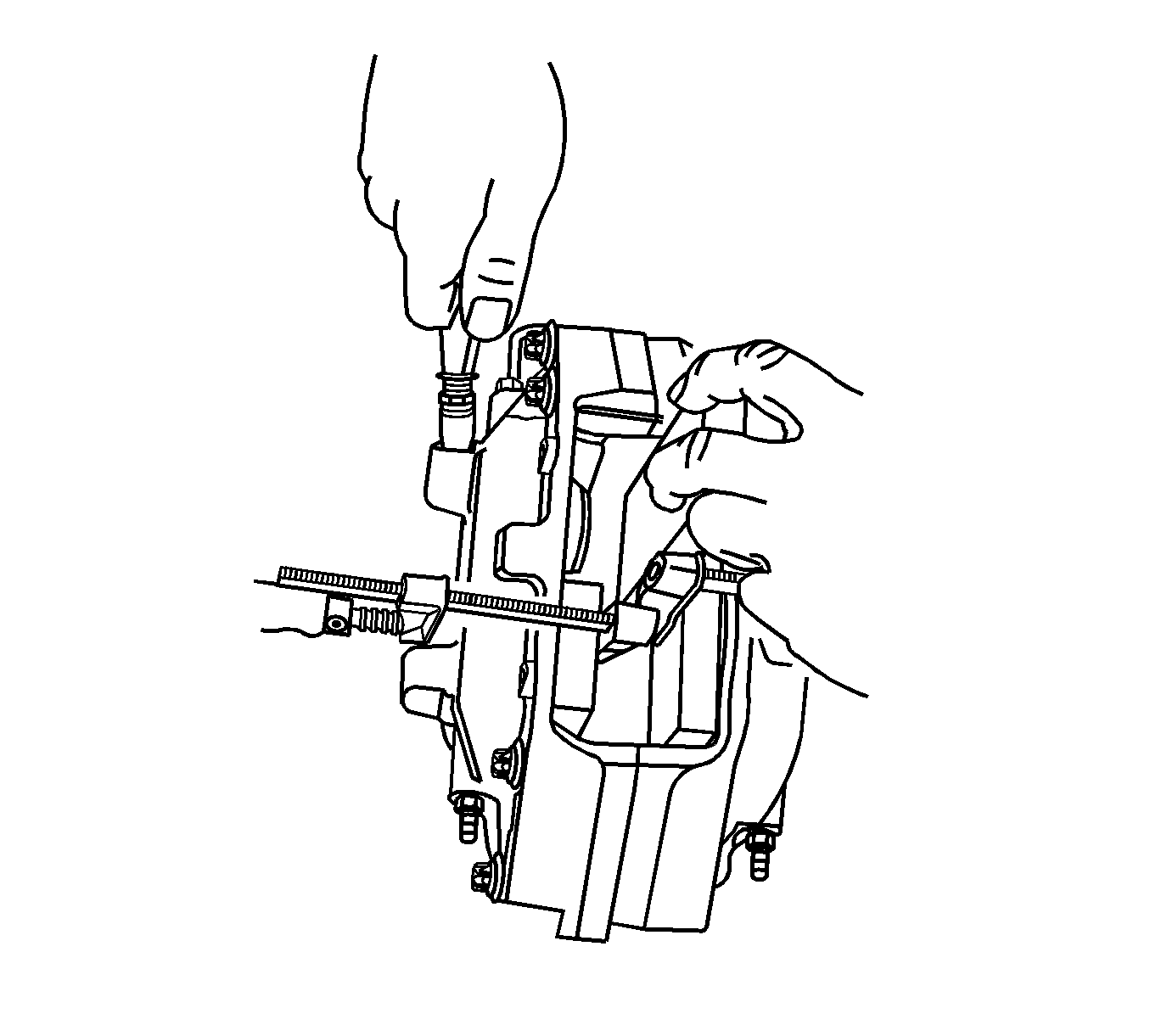
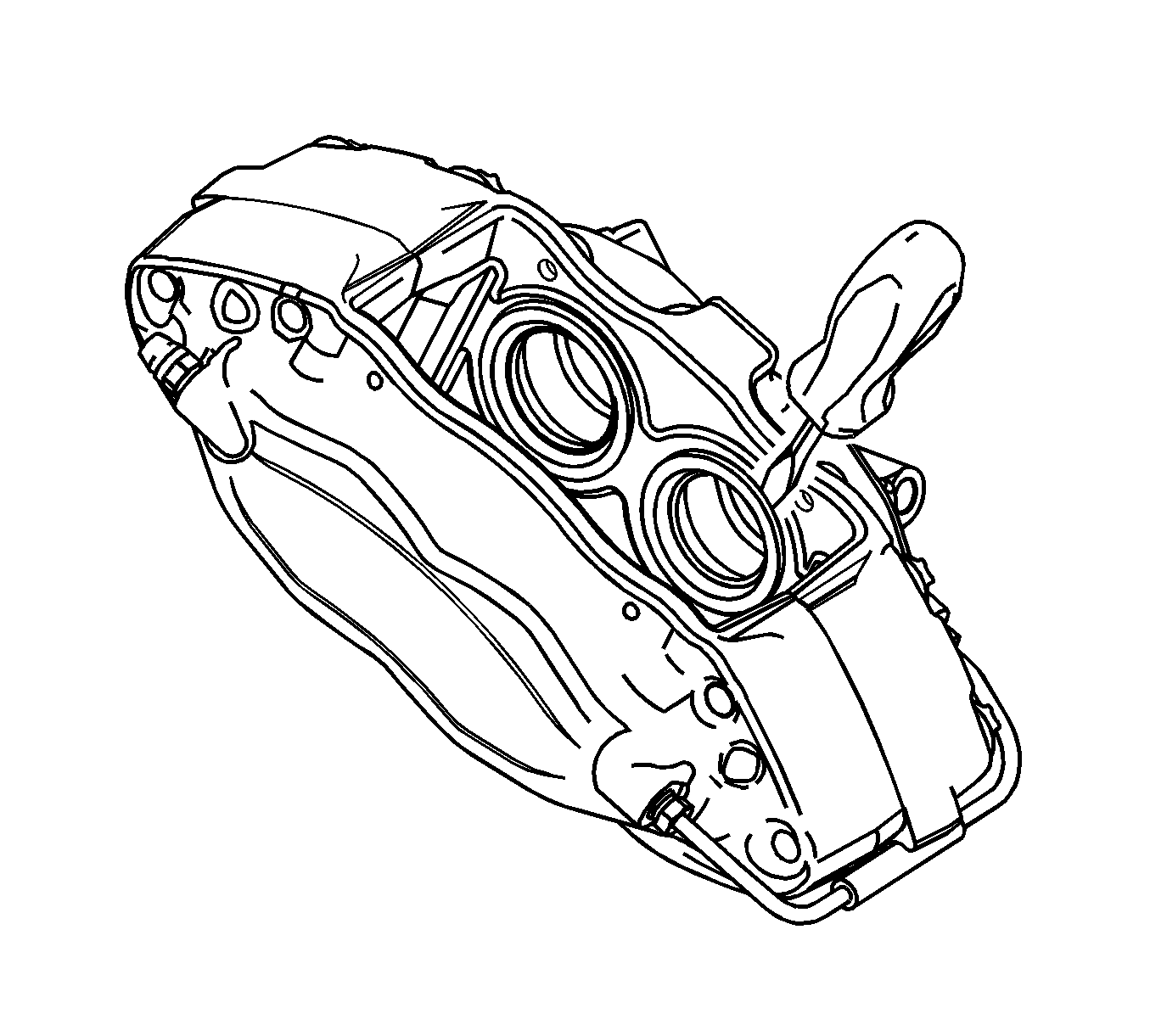
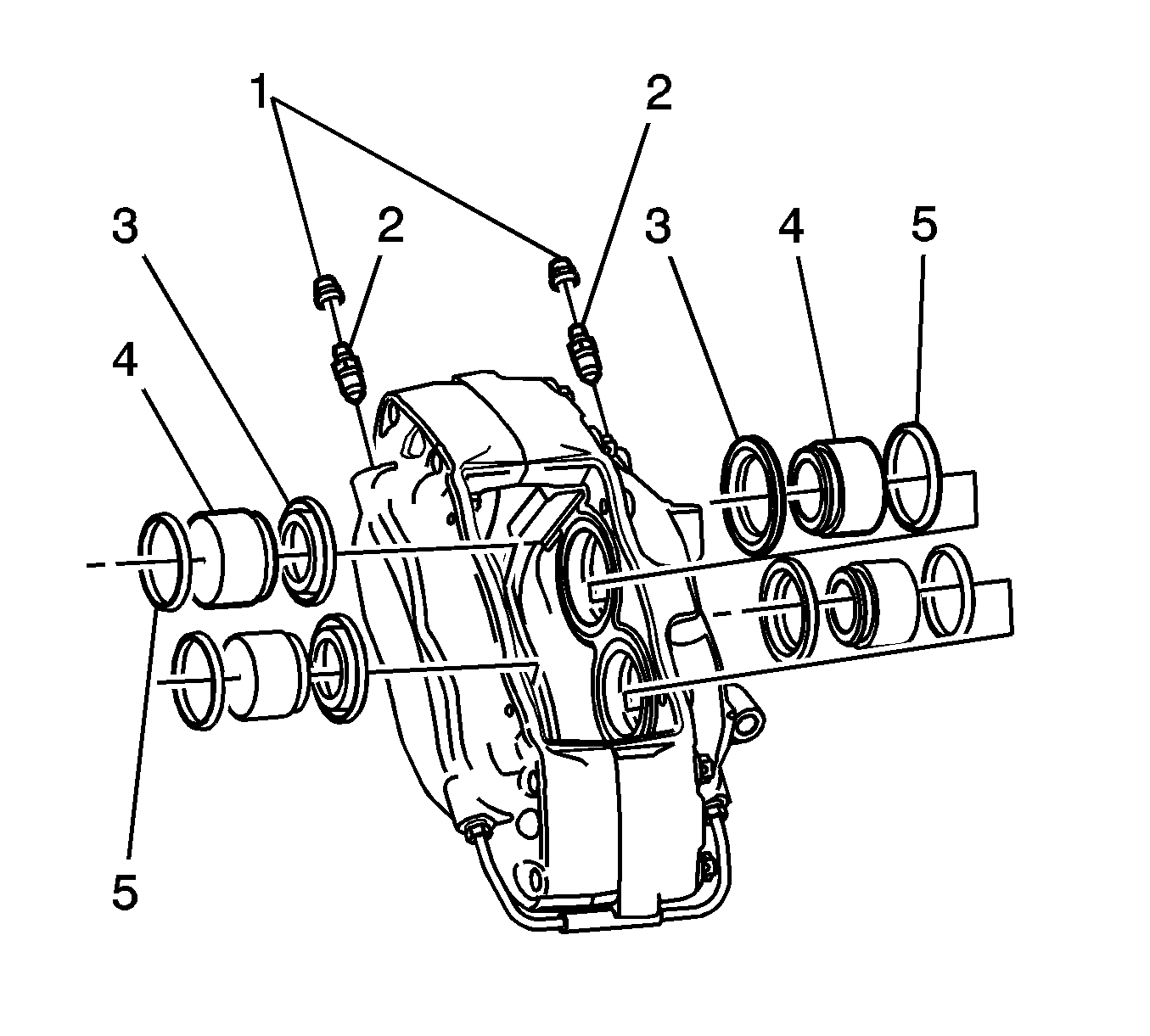
Important: Do NOT clean the caliper piston bores by honing or cleaning with abrasives.
Assembly Procedure
- Install the new piston dust boot seals (3) over the pistons (4). Make sure the dust boot seal is properly seated on the piston, in the dust boot seal groove.
- Lubricate the new piston seals (5) with Delco Supreme 11®, GM P/N 12377967 (Canadian P/N 992667) or equivalent DOT-3 brake fluid from a clean, sealed brake fluid container.
- Install the lubricated, new piston seals (5) into the brake caliper bore seal grooves. Make sure the seals are not twisted.
- Apply a thin coat of Delco Supreme 11®, GM P/N 12377967 (Canadian P/N 992667) or equivalent DOT-3 brake fluid from a clean, sealed brake fluid container, onto the caliper piston bores and the outer surface of the caliper pistons.
- Install the piston and dust boot assemblies into the correct caliper bores. Press the pistons and dust boot seals all the way in by hand.
- Place a clean old brake pad or the fabricated 127 mm (5 in) long block of wood over 2 adjoining piston bores and apply light pressure with non-marring C-clamp. This will ensure the dust boots and pistons are fully seated into the caliper.
- Repeat step 6 for the opposite pistons.
- Install the brake caliper bleeder valves (2).
- Install the brake caliper bleeder valve caps (1).
- Install the caliper to the vehicle. Refer to Front Brake Caliper Replacement .

Notice: Refer to Fastener Notice in the Preface section.
Tighten
Tighten the valves to 14 N·m (124 lb in).
